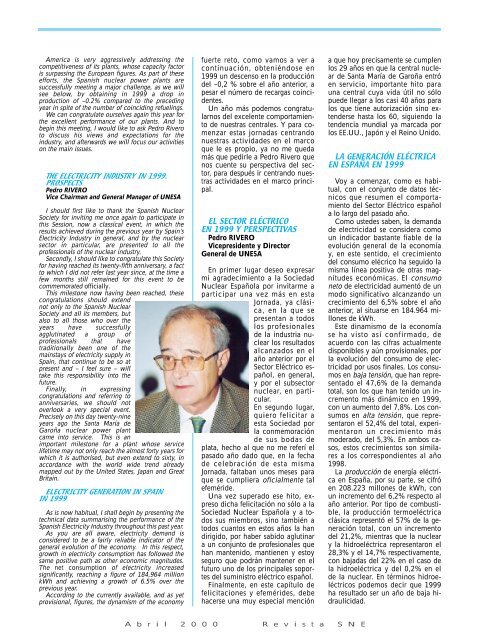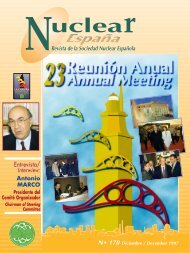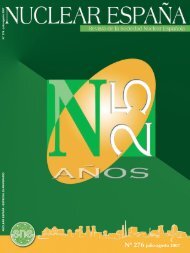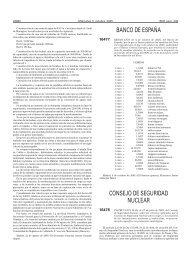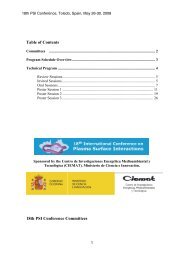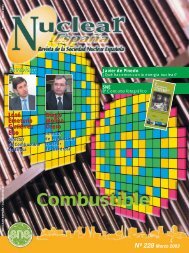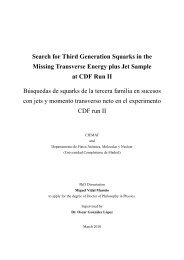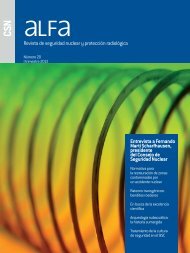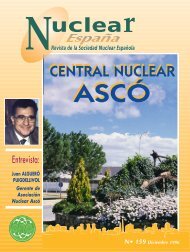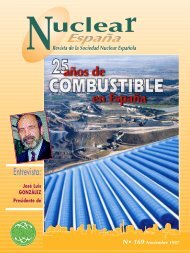EntrEntr evista/evista/ InterInter viewview
EntrEntr evista/evista/ InterInter viewview
EntrEntr evista/evista/ InterInter viewview
Create successful ePaper yourself
Turn your PDF publications into a flip-book with our unique Google optimized e-Paper software.
America is very aggressively addressing the<br />
competitiveness of its plants, whose capacity factor<br />
is surpassing the European figures. As part of these<br />
efforts, the Spanish nuclear power plants are<br />
successfully meeting a major challenge, as we will<br />
see below, by obtaining in 1999 a drop in<br />
production of –0.2% compared to the preceding<br />
year in spite of the number of coinciding refuelings.<br />
We can congratulate ourselves again this year for<br />
the excellent performance of our plants. And to<br />
begin this meeting, I would like to ask Pedro Rivero<br />
to discuss his views and expectations for the<br />
industry, and afterwards we will focus our activities<br />
on the main issues.<br />
THE ELECTRICITY INDUSTRY IN 1999.<br />
PROSPECTS<br />
Pedro RIVERO<br />
Vice Chairman and General Manager of UNESA<br />
I should first like to thank the Spanish Nuclear<br />
Society for inviting me once again to participate in<br />
this Session, now a classical event, in which the<br />
results achieved during the previous year by Spain’s<br />
Electricity Industry in general, and by the nuclear<br />
sector in particular, are presented to all the<br />
professionals of the nuclear industry.<br />
Secondly, I should like to congratulate this Society<br />
for having reached its twenty-fifth anniversary, a fact<br />
to which I did not refer last year since, at the time a<br />
few months still remained for this event to be<br />
commemorated officially.<br />
This milestone now having been reached, these<br />
congratulations should extend<br />
not only to the Spanish Nuclear<br />
Society and all its members, but<br />
also to all those who over the<br />
years have successfully<br />
agglutinated a group of<br />
professionals that have<br />
traditionally been one of the<br />
mainstays of electricity supply in<br />
Spain, that continue to be so at<br />
present and – I feel sure – will<br />
take this responsibility into the<br />
future.<br />
Finally, in expressing<br />
congratulations and referring to<br />
anniversaries, we should not<br />
overlook a very special event.<br />
Precisely on this day twenty-nine<br />
years ago the Santa María de<br />
Garoña nuclear power plant<br />
came into service. This is an<br />
important milestone for a plant whose service<br />
lifetime may not only reach the almost forty years for<br />
which it is authorised, but even extend to sixty, in<br />
accordance with the world wide trend already<br />
mapped out by the United States, Japan and Great<br />
Britain.<br />
ELECTRICITY GENERATION IN SPAIN<br />
IN 1999<br />
As is now habitual, I shall begin by presenting the<br />
technical data summarising the performance of the<br />
Spanish Electricity Industry throughout this past year.<br />
As you are all aware, electricity demand is<br />
considered to be a fairly reliable indicator of the<br />
general evolution of the economy. In this respect,<br />
growth in electricity consumption has followed the<br />
same positive path as other economic magnitudes.<br />
The net consumption of electricity increased<br />
significantly, reaching a figure of 184,964 million<br />
kWh and achieving a growth of 6.5% over the<br />
previous year.<br />
According to the currently available, and as yet<br />
provisional, figures, the dynamism of the economy<br />
fuerte reto, como vamos a ver a<br />
continuación, obteniéndose en<br />
1999 un descenso en la producción<br />
del –0,2 % sobre el año anterior, a<br />
pesar el número de recargas coincidentes.<br />
Un año más podemos congratularnos<br />
del excelente comportamiento<br />
de nuestras centrales. Y para comenzar<br />
estas jornadas centrando<br />
nuestras actividades en el marco<br />
que le es propio, ya no me queda<br />
más que pedirle a Pedro Rivero que<br />
nos cuente su perspectiva del sector,<br />
para después ir centrando nuestras<br />
actividades en el marco principal.<br />
EL SECTOR ELƒCTRICO<br />
EN 1999 Y PERSPECTIVAS<br />
Pedro RIVERO<br />
Vicepresidente y Director<br />
General de UNESA<br />
En primer lugar deseo expresar<br />
mi agradecimiento a la Sociedad<br />
Nuclear Española por invitarme a<br />
participar una vez más en esta<br />
Jornada, ya clásica,<br />
en la que se<br />
presentan a todos<br />
los profesionales<br />
de la industria nuclear<br />
los resultados<br />
alcanzados en el<br />
año anterior por el<br />
Sector Eléctrico español,<br />
en general,<br />
y por el subsector<br />
nuclear, en particular.<br />
En segundo lugar,<br />
quiero felicitar a<br />
esta Sociedad por<br />
la conmemoración<br />
de sus bodas de<br />
plata, hecho al que no me referí el<br />
pasado año dado que, en la fecha<br />
de celebración de esta misma<br />
Jornada, faltaban unos meses para<br />
que se cumpliera oficialmente tal<br />
efeméride.<br />
Una vez superado ese hito, expreso<br />
dicha felicitación no sólo a la<br />
Sociedad Nuclear Española y a todos<br />
sus miembros, sino también a<br />
todos cuantos en estos años la han<br />
dirigido, por haber sabido aglutinar<br />
a un conjunto de profesionales que<br />
han mantenido, mantienen y estoy<br />
seguro que podrán mantener en el<br />
futuro uno de los principales soportes<br />
del suministro eléctrico español.<br />
Finalmente, en este capítulo de<br />
felicitaciones y efemérides, debe<br />
hacerse una muy especial mención<br />
a que hoy precisamente se cumplen<br />
los 29 años en que la central nuclear<br />
de Santa María de Garoña entró<br />
en servicio, importante hito para<br />
una central cuya vida útil no sólo<br />
puede llegar a los casi 40 años para<br />
los que tiene autorización sino extenderse<br />
hasta los 60, siguiendo la<br />
tendencia mundial ya marcada por<br />
los EE.UU., Japón y el Reino Unido.<br />
LA GENERACIîN ELƒCTRICA<br />
EN ESPA„A EN 1999<br />
Voy a comenzar, como es habitual,<br />
con el conjunto de datos técnicos<br />
que resumen el comportamiento<br />
del Sector Eléctrico español<br />
a lo largo del pasado año.<br />
Como ustedes saben, la demanda<br />
de electricidad se considera como<br />
un indicador bastante fiable de la<br />
evolución general de la economía<br />
y, en este sentido, el crecimiento<br />
del consumo elécrico ha seguido la<br />
misma línea positiva de otras magnitudes<br />
económicas. El consumo<br />
neto de electricidad aumentó de un<br />
modo significativo alcanzando un<br />
crecimiento del 6,5% sobre el año<br />
anterior, al situarse en 184.964 millones<br />
de kWh.<br />
Este dinamismo de la economía<br />
se ha visto así confirmado, de<br />
acuerdo con las cifras actualmente<br />
disponibles y aún provisionales, por<br />
la evolución del consumo de electricidad<br />
por usos finales. Los consumos<br />
en baja tensión, que han representado<br />
el 47,6% de la demanda<br />
total, son los que han tenido un incremento<br />
más dinámico en 1999,<br />
con un aumento del 7,8%. Los consumos<br />
en alta tensión, que representaron<br />
el 52,4% del total, experimentaron<br />
un crecimiento más<br />
moderado, del 5,3%. En ambos casos,<br />
estos crecimientos son similares<br />
a los correspondientes al año<br />
1998.<br />
La producción de energía eléctrica<br />
en España, por su parte, se cifró<br />
en 208.223 millones de kWh, con<br />
un incremento del 6,2% respecto al<br />
año anterior. Por tipo de combustible,<br />
la producción termoeléctrica<br />
clásica representó el 57% de la generación<br />
total, con un incremento<br />
del 21,2%, mientras que la nuclear<br />
y la hidroeléctrica representaron el<br />
28,3% y el 14,7% respectivamente,<br />
con bajadas del 22% en el caso de<br />
la hidroeléctrica y del 0,2% en el<br />
de la nuclear. En términos hidroeléctricos<br />
podemos decir que 1999<br />
ha resultado ser un año de baja hidraulicidad.<br />
A b r i l 2 0 0 0<br />
R e v i s t a S N E


